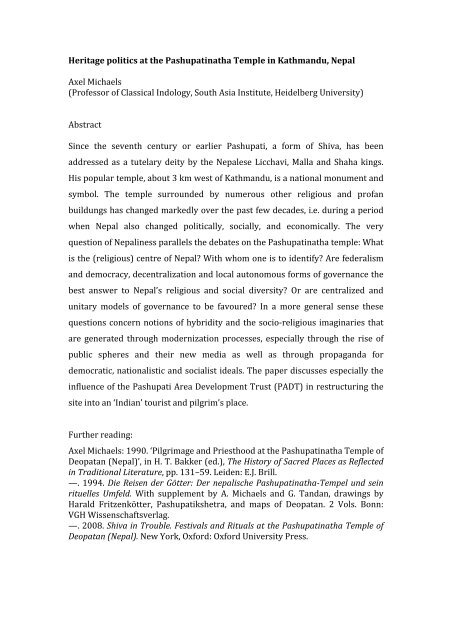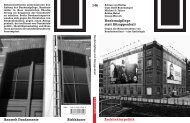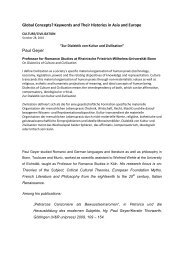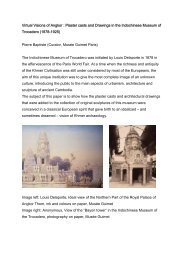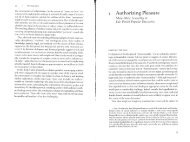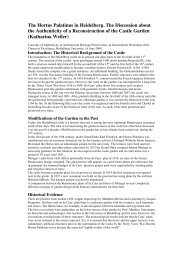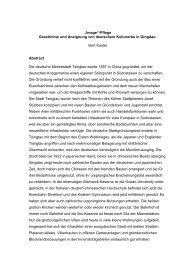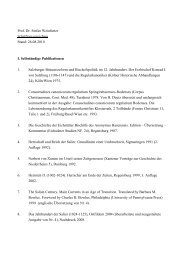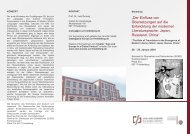Rituals and archaeological preservation: the Pashupatinath temple in
Rituals and archaeological preservation: the Pashupatinath temple in
Rituals and archaeological preservation: the Pashupatinath temple in
Create successful ePaper yourself
Turn your PDF publications into a flip-book with our unique Google optimized e-Paper software.
Heritage politics at <strong>the</strong> <strong>Pashupat<strong>in</strong>ath</strong>a Temple <strong>in</strong> Kathm<strong>and</strong>u, Nepal<br />
Axel Michaels<br />
(Professor of Classical Indology, South Asia Institute, Heidelberg University)<br />
Abstract<br />
S<strong>in</strong>ce <strong>the</strong> seventh century or earlier Pashupati, a form of Shiva, has been<br />
addressed as a tutelary deity by <strong>the</strong> Nepalese Licchavi, Malla <strong>and</strong> Shaha k<strong>in</strong>gs.<br />
His popular <strong>temple</strong>, about 3 km west of Kathm<strong>and</strong>u, is a national monument <strong>and</strong><br />
symbol. The <strong>temple</strong> surrounded by numerous o<strong>the</strong>r religious <strong>and</strong> profan<br />
buildungs has changed markedly over <strong>the</strong> past few decades, i.e. dur<strong>in</strong>g a period<br />
when Nepal also changed politically, socially, <strong>and</strong> economically. The very<br />
question of Nepal<strong>in</strong>ess parallels <strong>the</strong> debates on <strong>the</strong> <strong>Pashupat<strong>in</strong>ath</strong>a <strong>temple</strong>: What<br />
is <strong>the</strong> (religious) centre of Nepal? With whom one is to identify? Are federalism<br />
<strong>and</strong> democracy, decentralization <strong>and</strong> local autonomous forms of governance <strong>the</strong><br />
best answer to Nepal’s religious <strong>and</strong> social diversity? Or are centralized <strong>and</strong><br />
unitary models of governance to be favoured? In a more general sense <strong>the</strong>se<br />
questions concern notions of hybridity <strong>and</strong> <strong>the</strong> socio‐religious imag<strong>in</strong>aries that<br />
are generated through modernization processes, especially through <strong>the</strong> rise of<br />
public spheres <strong>and</strong> <strong>the</strong>ir new media as well as through propag<strong>and</strong>a for<br />
democratic, nationalistic <strong>and</strong> socialist ideals. The paper discusses especially <strong>the</strong><br />
<strong>in</strong>fluence of <strong>the</strong> Pashupati Area Development Trust (PADT) <strong>in</strong> restructur<strong>in</strong>g <strong>the</strong><br />
site <strong>in</strong>to an ‘Indian’ tourist <strong>and</strong> pilgrim’s place.<br />
Fur<strong>the</strong>r read<strong>in</strong>g:<br />
Axel Michaels: 1990. ‘Pilgrimage <strong>and</strong> Priesthood at <strong>the</strong> <strong>Pashupat<strong>in</strong>ath</strong>a Temple of<br />
Deopatan (Nepal)’, <strong>in</strong> H. T. Bakker (ed.), The History of Sacred Places as Reflected<br />
<strong>in</strong> Traditional Literature, pp. 131–59. Leiden: E.J. Brill.<br />
—. 1994. Die Reisen der Götter: Der nepalische <strong>Pashupat<strong>in</strong>ath</strong>aTempel und se<strong>in</strong><br />
rituelles Umfeld. With supplement by A. Michaels <strong>and</strong> G. T<strong>and</strong>an, draw<strong>in</strong>gs by<br />
Harald Fritzenkötter, Pashupatikshetra, <strong>and</strong> maps of Deopatan. 2 Vols. Bonn:<br />
VGH Wissenschaftsverlag.<br />
—. 2008. Shiva <strong>in</strong> Trouble. Festivals <strong>and</strong> <strong>Rituals</strong> at <strong>the</strong> <strong>Pashupat<strong>in</strong>ath</strong>a Temple of<br />
Deopatan (Nepal). New York, Oxford: Oxford University Press.
Curriculum Vitae<br />
s<strong>in</strong>ce 2007 Co-Director of <strong>the</strong> Excellence Cluster „Asia <strong>and</strong> Europe <strong>in</strong> a Global Context“<br />
s<strong>in</strong>ce 2002 Speaker of <strong>the</strong> Collaborative Research Centre “The Dynamics of Ritual”<br />
s<strong>in</strong>ce 1998 Professor of Classical Indology, South Asia Institute, University of<br />
Heidelberg<br />
1992 Professor of Religious Studies, University of Berne<br />
1986 Visit<strong>in</strong>g Fellow at Wolfson College, Oxford; Ademischer Rat, Dept. of<br />
Indology, University of Kiel<br />
1991 Habilitation<br />
1983–1991 Assistant Professor, Dept. of Indology, University of Kiel<br />
1981–1983 Director of <strong>the</strong> Nepal Research Centre <strong>and</strong> <strong>the</strong> Nepal-German<br />
Preservation Projects <strong>in</strong> Kathm<strong>and</strong>u<br />
1971–1981 Benares H<strong>in</strong>du University: Post-graduate Course <strong>in</strong> Indian Religion <strong>and</strong><br />
Philosophy; Researcher at <strong>the</strong> Hamburgische Völkerkundemuesum; Assistant<br />
Professor at <strong>the</strong> Universities of Muenster <strong>and</strong> Kiel<br />
1968–1971 Studies of Law, Sociology <strong>and</strong> Philosophy, University of Munich <strong>and</strong><br />
Freiburg<br />
Honours<br />
Full Member of <strong>the</strong> Heidelberger Academy of Sciences (s<strong>in</strong>ce 2006); State<br />
Teach<strong>in</strong>g Award Baden-Württemberg (2005) ; Heisenberg Fellowship (1990); Spald<strong>in</strong>g<br />
Visit<strong>in</strong>g Fellow at Wolfson College, Oxford (1986)<br />
Fields of Interest<br />
Ethno-Indology; Social <strong>and</strong> Legal History of H<strong>in</strong>duism; Cultural History of Nepal;<br />
Ritual studies<br />
Current Research Projects<br />
“Lyfe-cycle rituals <strong>in</strong> Nepal” (with<strong>in</strong> DFG-SFB 619, 2002–2012); „Religion on stage“<br />
(with Excellence Cluster Asia <strong>and</strong> Europe <strong>in</strong> a Global Context<br />
Book Publications (selection)<br />
(with Niels Gutschow): Grow<strong>in</strong>g up.H<strong>in</strong>du <strong>and</strong> Buddhist Initiation <strong>Rituals</strong> among<br />
Newar Children <strong>in</strong> Bhaktapur, Nepal, Wiesbaden: Harrassowitz, 2008.<br />
Price <strong>and</strong> Purity: The Religious Judge <strong>in</strong> 19th Century Nepal. Conta<strong>in</strong><strong>in</strong>g <strong>the</strong><br />
edition <strong>and</strong> translation of <strong>the</strong> chapters on <strong>the</strong> Dharmadhikar<strong>in</strong> <strong>in</strong> two A<strong>in</strong>s,<br />
Tor<strong>in</strong>o: CESMEO, 2006.<br />
(with Niels Gutschow): H<strong>and</strong>l<strong>in</strong>g Death. The dynamics of Death <strong>and</strong> Ancestor<br />
<strong>Rituals</strong> among <strong>the</strong> Newars of Bhaktapur, Nepal, Wiesbaden: Harrassowitz,<br />
2005.<br />
H<strong>in</strong>duism. Past <strong>and</strong> Present. Transl. by Barbara Harshaw. Pr<strong>in</strong>ceton: Pr<strong>in</strong>ceton<br />
University Press 2004 (German Orig<strong>in</strong>al: Der H<strong>in</strong>duismus: Geschichte und<br />
Gegenwart, München 1998, 2nd ed. 2006).<br />
Reisen der Götter. Der nepalische <strong>Pashupat<strong>in</strong>ath</strong>a-Tempel und se<strong>in</strong> rituelles<br />
Umfeld, 2 parts, Bonn: VGH Wissenschaftsverlag, 1994.<br />
Beweisverfahren <strong>in</strong> der vedischen Sakralgeometrie. E<strong>in</strong> Beitrag zur<br />
Entstehungsgeschichte von Wissenschaft, Wiesbaden: Franz Ste<strong>in</strong>er Verlag,<br />
1978.<br />
Edited books (selection)<br />
Die neue Kraft der Rituale, Heidelberg: W<strong>in</strong>ter 2007, 2nd. ed. 2008.<br />
(with Jan Assmann <strong>and</strong> Franz Maciejewski): Der Abschied von den Toten.<br />
Trauerrituale im Kulturvergleich, Gött<strong>in</strong>gen: Wallste<strong>in</strong>, 2nd. ed. 2007.<br />
Klassiker der Religionswissenschaft, München: Beck, 2nd ed. 2004.


